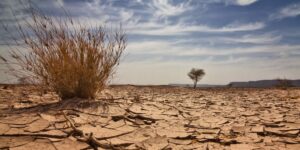Sadia Sajjad1, Dr. Muhammad Tahir1.
1 Department of Agronomy, University of Agriculture, Faisalabad.
Future global climate change, with predicted rise in temperature from 1.5-5.8°C by year 2100 is creating heat stress which is a major threat to agricultural production in Pakistan and worldwide.
Heat stress is an abiotic stress known as a rise in temperature beyond the threshold level for a period of time and enough to cause irreversible damage to plant growth and development which ultimately leads to low yield of crop.
Generally transient elevation in temperature 10-15oC above ambient is considered as heat stress for plants. Due to global warming and greenhouse gases, heat stress is becoming a major limiting factor for better crop production and high yield. There exist a much variability in plant responses to heat stress. According to the sensitivity to heat stress plants are categorized into sensitive, facultative tolerant and tolerant to heat stress. Sensitive crop would be more prone to heat stress than other crops.
Heat-Stress Threshold
A threshold temperature defined as value of daily mean temperature at which a detectable reduction in growth of plants begins. Threshold temperature is different for different species. In some plant species, the higher threshold temperature may be lower or higher than 35°C. Heat stress is a big issue in tropical and sub-tropical climates. In those areas heat stress becomes a major limiting factor for low yield of crop. In addition, heat stress makes the plant susceptible for more pest’s attack and other environmental problems. So there is a need to understand the mechanism of heat stress in plants.
Response of plant to heat stress
Heat stress cause delayed germination and loss of seed vigor. Reduced plant emergence leads to patchy crop establishment which is restraining factor towards high yield. Due to heat stress plants show wilting, scorchy leaves appearance, sunburn of twigs and branches. Leaf senescence, abscission and stunted growth. At anatomical level, there is high transpirational losses, closure of stomata and reduction in cell size. At sub-cellular level, heat stress disrupts the organization of thylakoid membrane, loss of thylakoid stacking or its swelling leads to low chlorophyll and photosynthesis. Due to high temperature mitochondrial cristae also affect.
Indirect injuries are inactivation of enzymes, denaturation of protein, inhibition of protein synthesis and loss of membranes integrity. Membrane fluidity increase due to damage to structural organization of membrane. At molecular level, oxidative stress also occurs as a secondary stress in response to heat stress. Reactive oxygen species cause major damage to cell functions. Singlet oxygen (1O2), Superoxide radical (O2-), hydrogen peroxide (H2O2) and hydroxyl radical (OH–) are reactive oxygen species in which hydroxyl radical is more damaging than other ROS.
Impact of heat stress on plant growth stages
Heat stress cause damage to plants at each stage but reproductive stage is more sensitive to heat stress. At germination stage of seed, heat stress affects the plant population of crop. If heat stress occurs at anthesis stage, pollens viability affects and result into less fertilization and less number of grains. If heat stress occurs at post-anthesis or grain filling stage, this leads to less dry matter partitioning from leaves to grains. All this results in the short grains size which also affect 1000 grains weight and economic yield of crop.

Mechanism of Heat Tolerance in Plants
Plants have evolved various mechanism against heat stress, which include short term avoidance, acclimation or long term adaptations to thrive in stressed environmental conditions. In short term response plant change their leaves orientation, transpiration for cooling effect and change in composition of cell membrane lipids. Plant show this response for initial heat stress signals in which cell osmotic balance disturb or fluidity of cell membrane change. In response to this signals plant try to reestablish proper osmoregulation and repair cell membrane structure.
When plants sense the heat stress, there are gene activation in cell to make some proteins, Heat Shock Proteins (HSP’s) which protect the cell from damage. Plants also produce late embryogenesis proteins (LEA), osmoprotectants such as glycine betaine, proline and some polyols which provide adaptation against heat stress. Accumulation of osmoprotectants in the cell helps in osmotic adjustment by maintain water balance and membrane fluidity. Osmoprotactants also act as buffers in the cells for cellular redox potential. This mechanism of plants against heat stress is known as thermotolerance which may be inherent ability of plant or acquired by regular exposure of plant to heat stress.
Improvement in Heat Tolerance Mechanism
When high temperature occurs year after year, plant adapt themselves by changing their leaves size into smaller, rolled leaves and having small hairs or thick waxy cuticle on leaves surface so that direct exposure of leaves with heat would be minimum. Plants have a mechanism to make own protection by producing different kind of proteins or sugars. There is a need to improve the efficiency of plants to make these protecting agents. For this genetic engineering is being used to add genes responsible for making more heat shock proteins or osmolytes. Overexpression of these genes will produce more osmoprotectants, which is a key mechanism of plants against abiotic stresses. These transgenic plants have more capabilities to survive under heat stress.
Recommendations
Therefore, to increase yield and to combat high temperature or heat stress in upcoming years due to global warming, there is a need to make heat tolerant verities of crops by genetic improvement.








